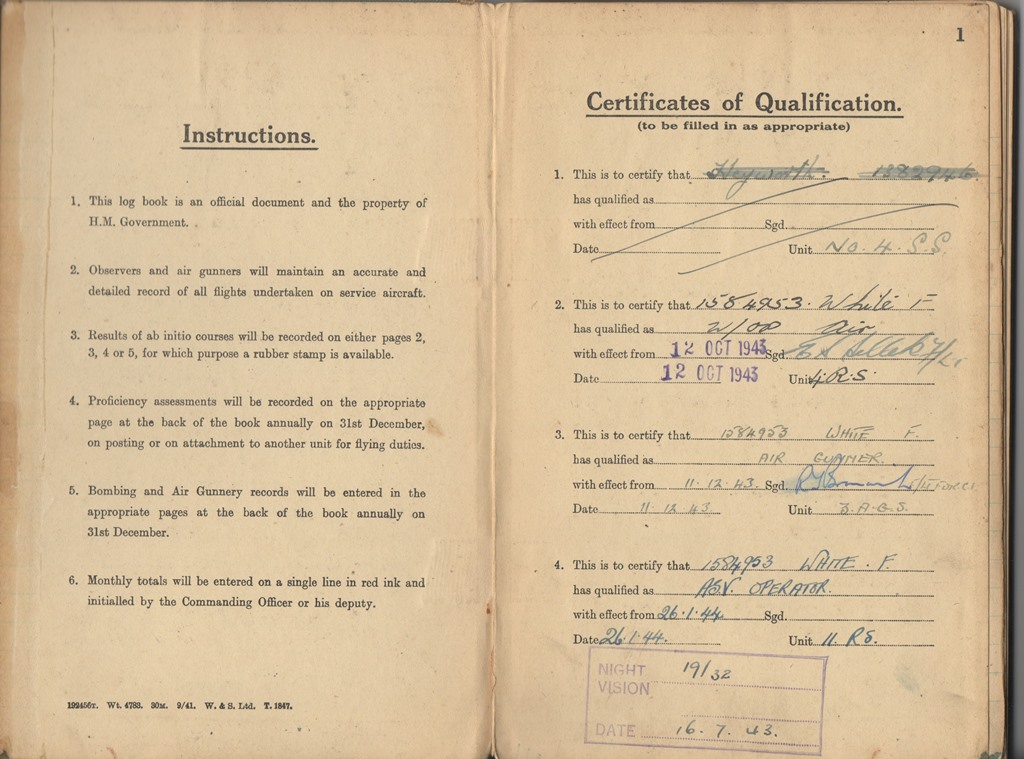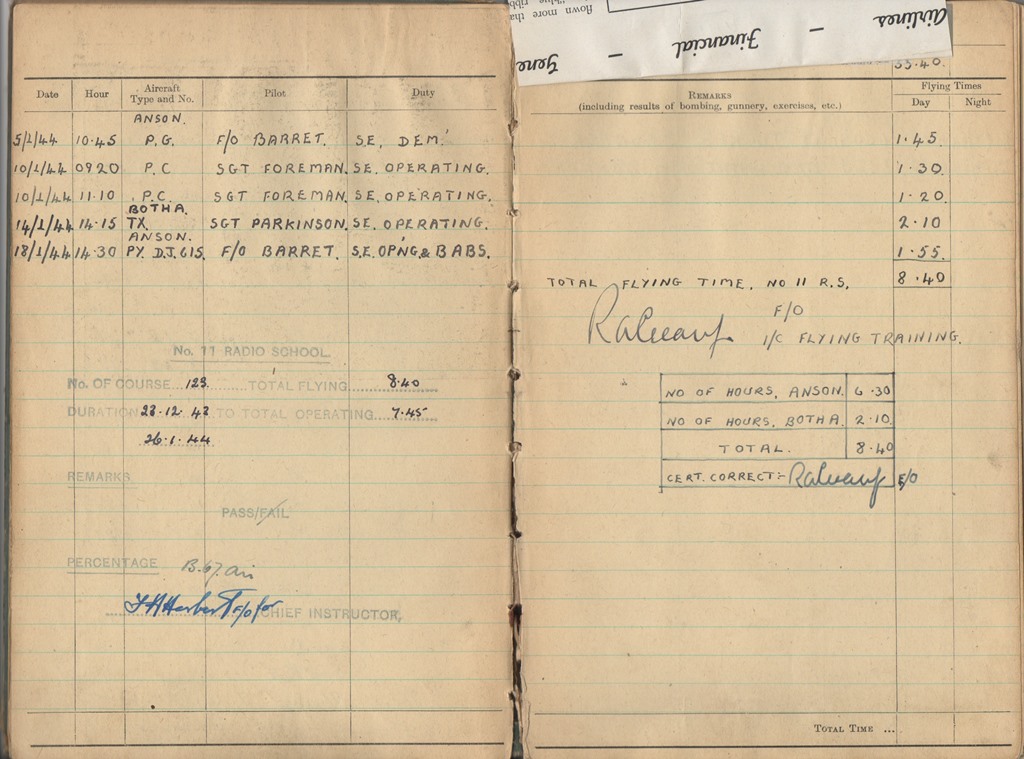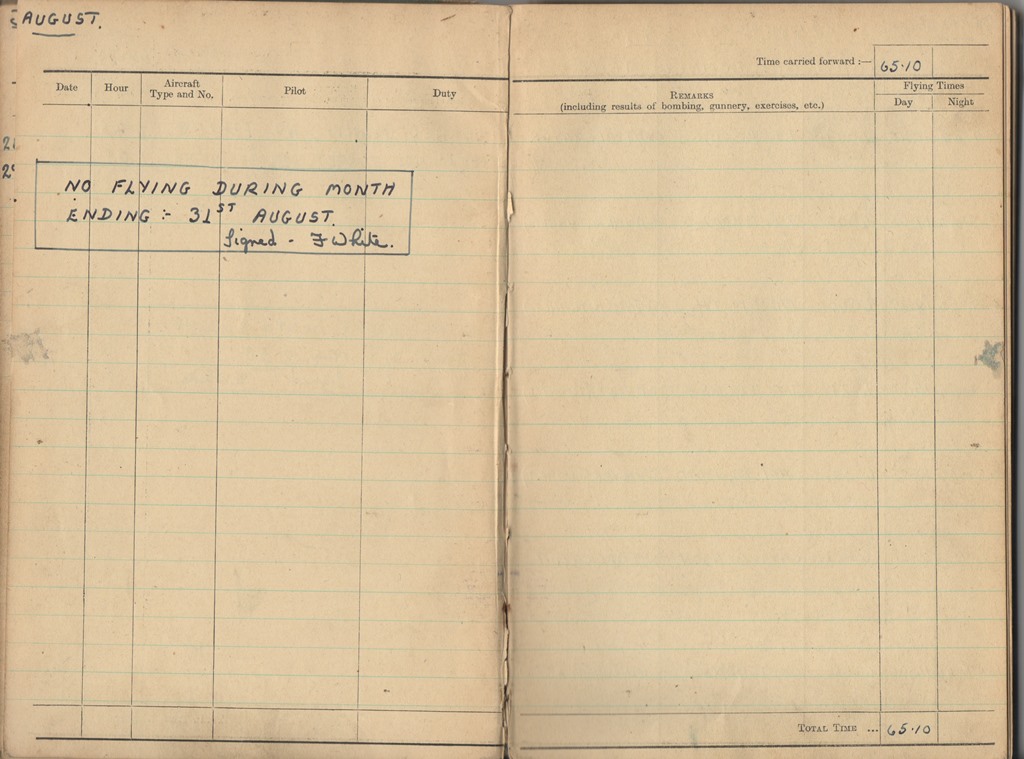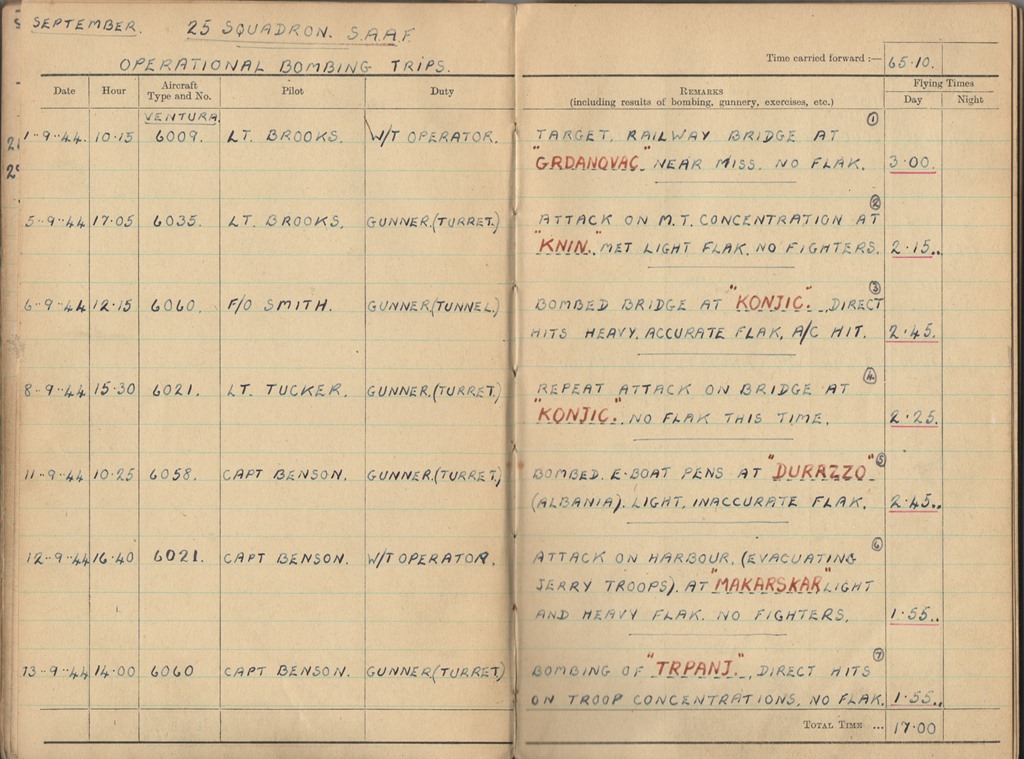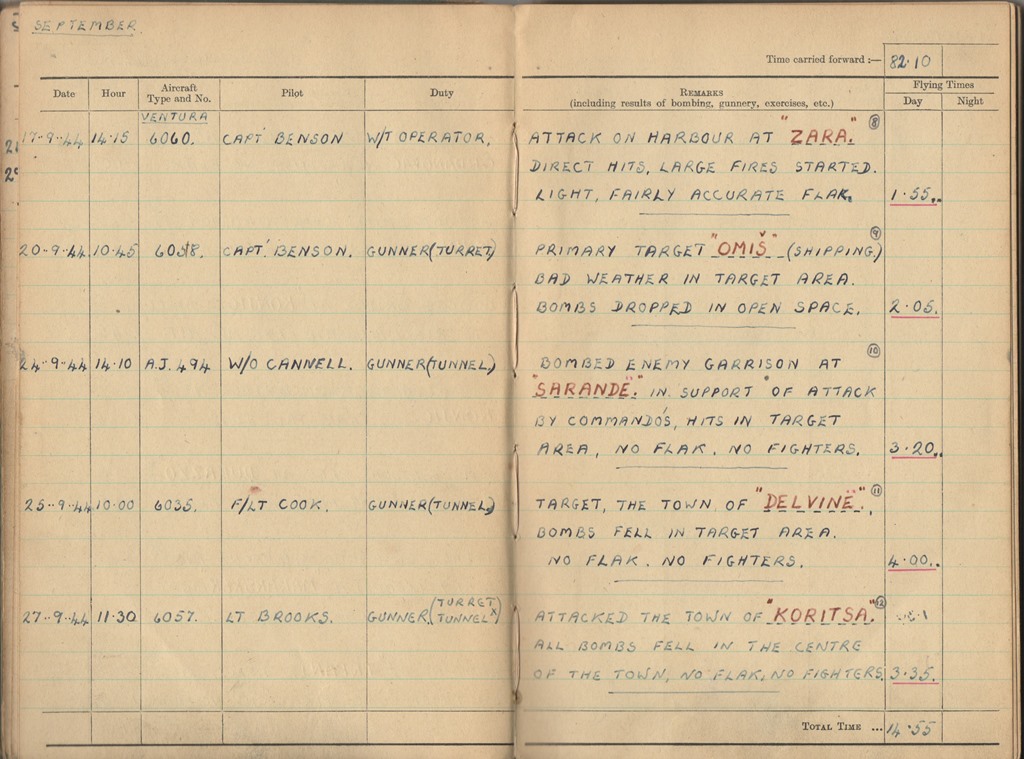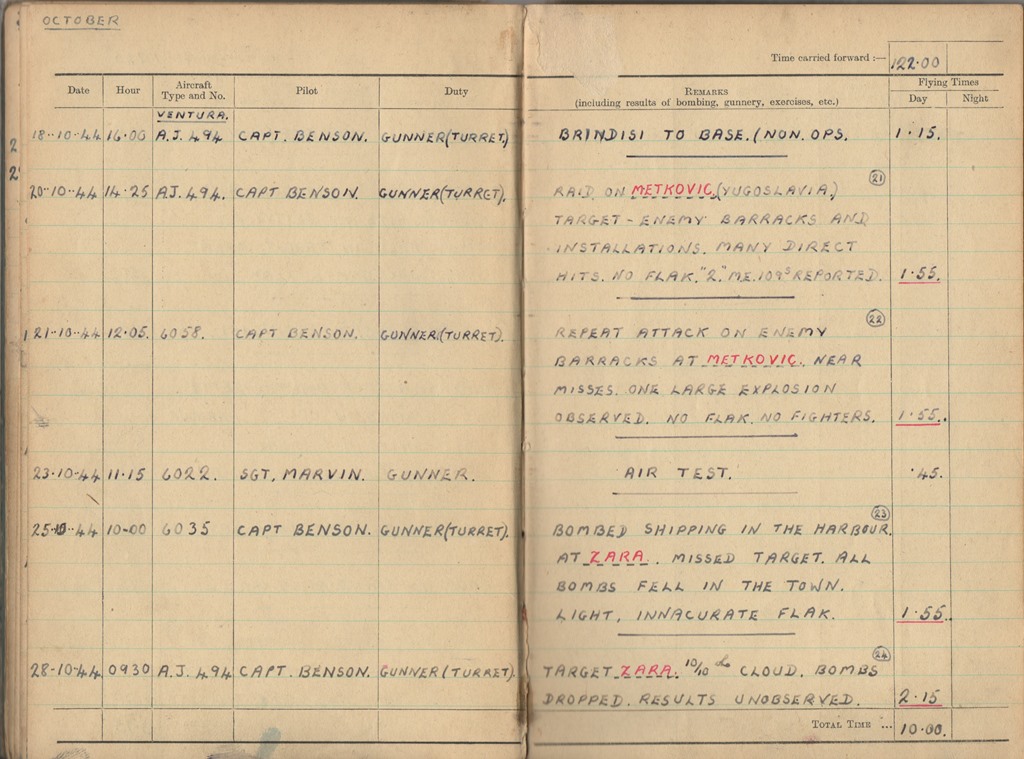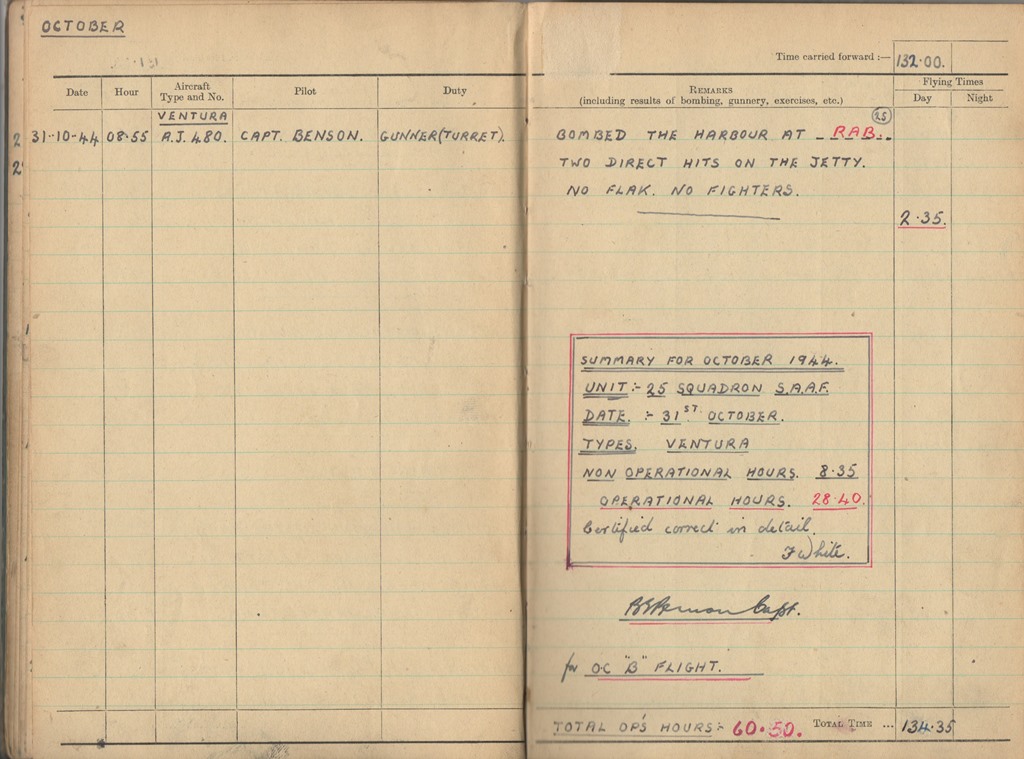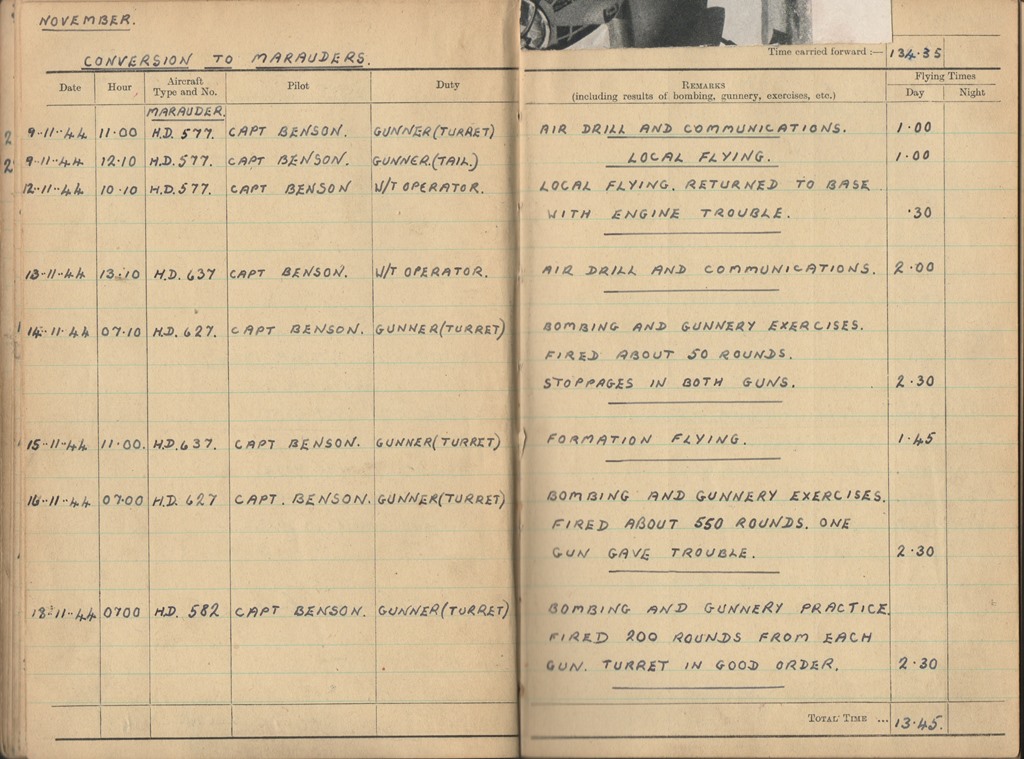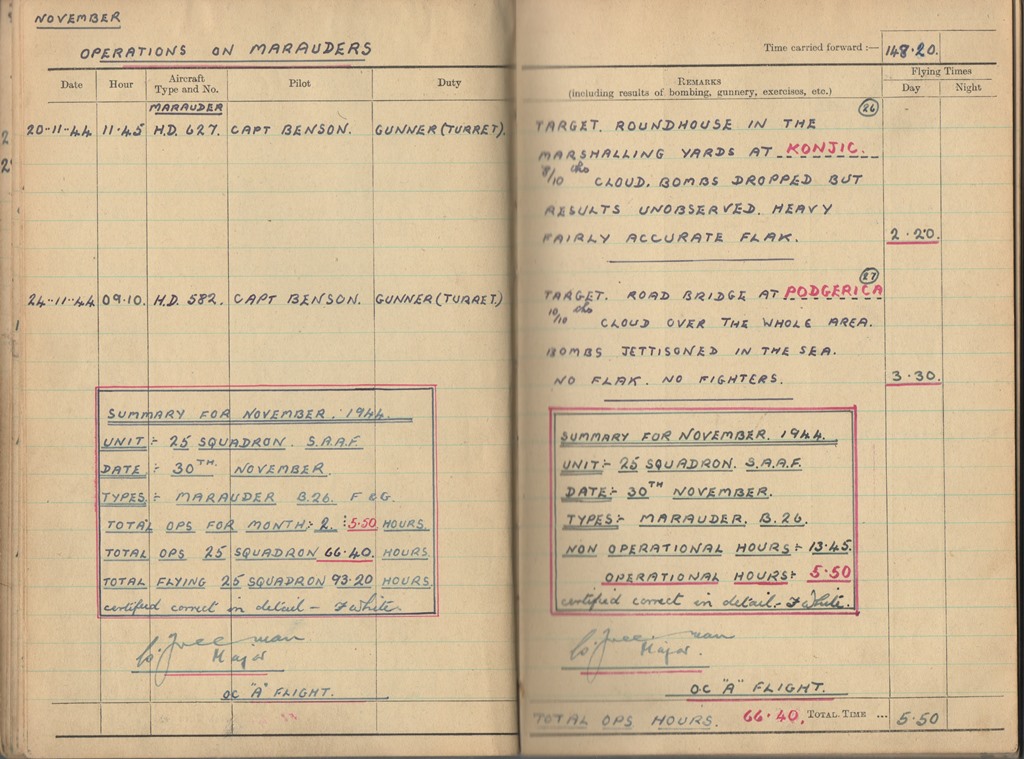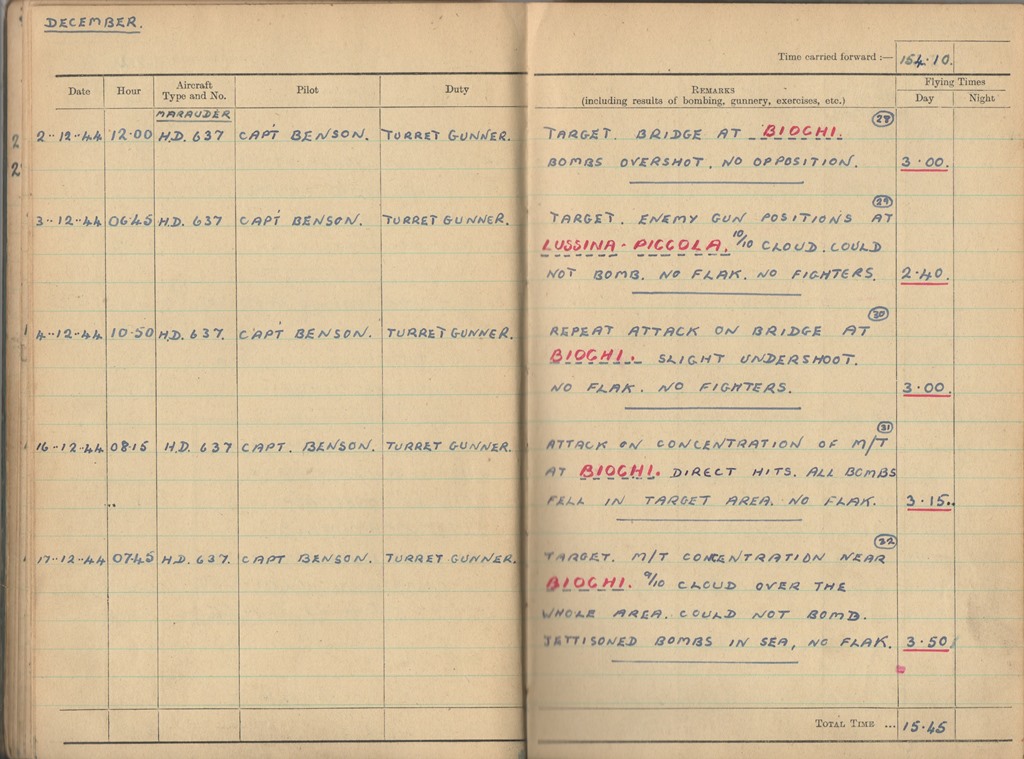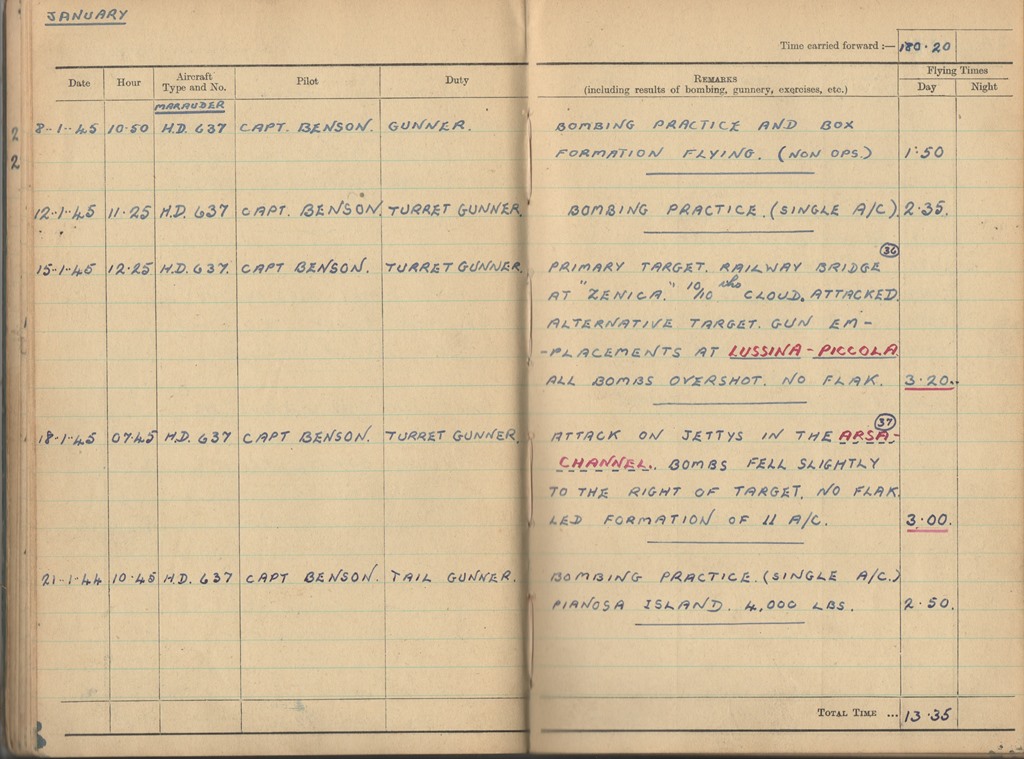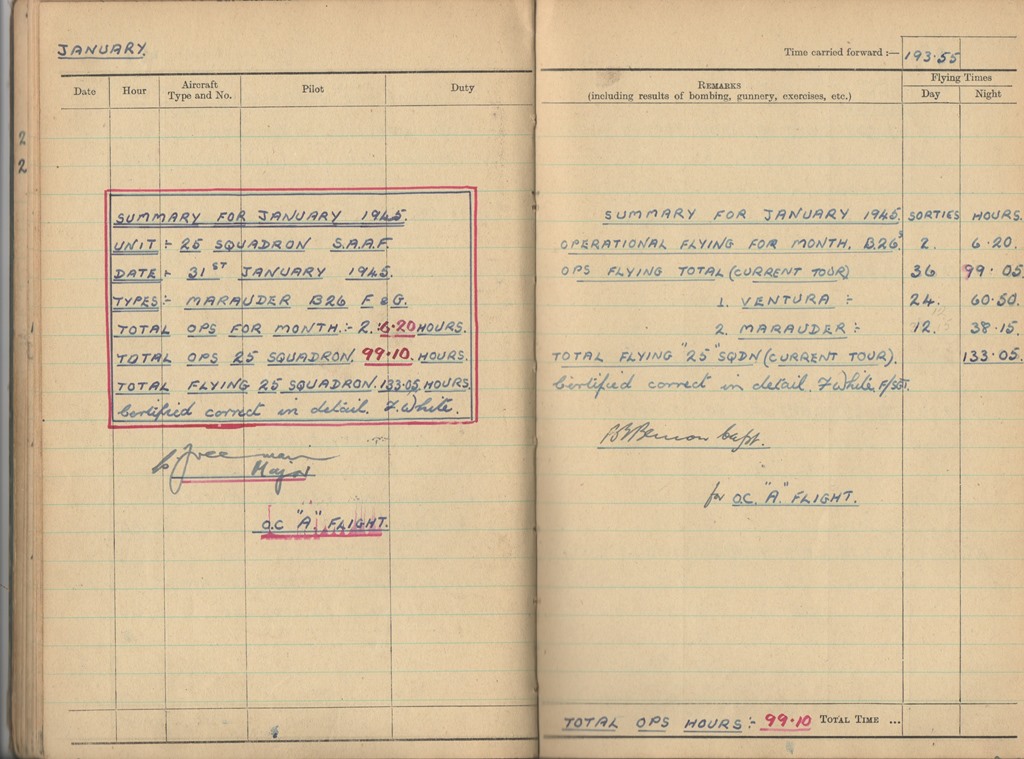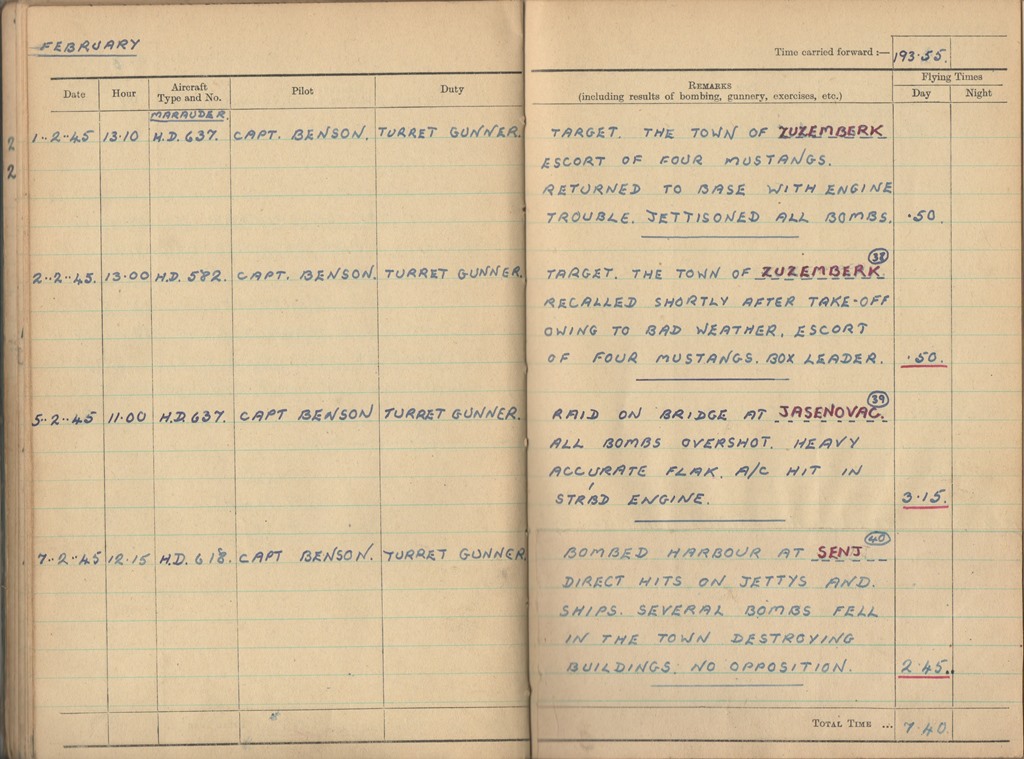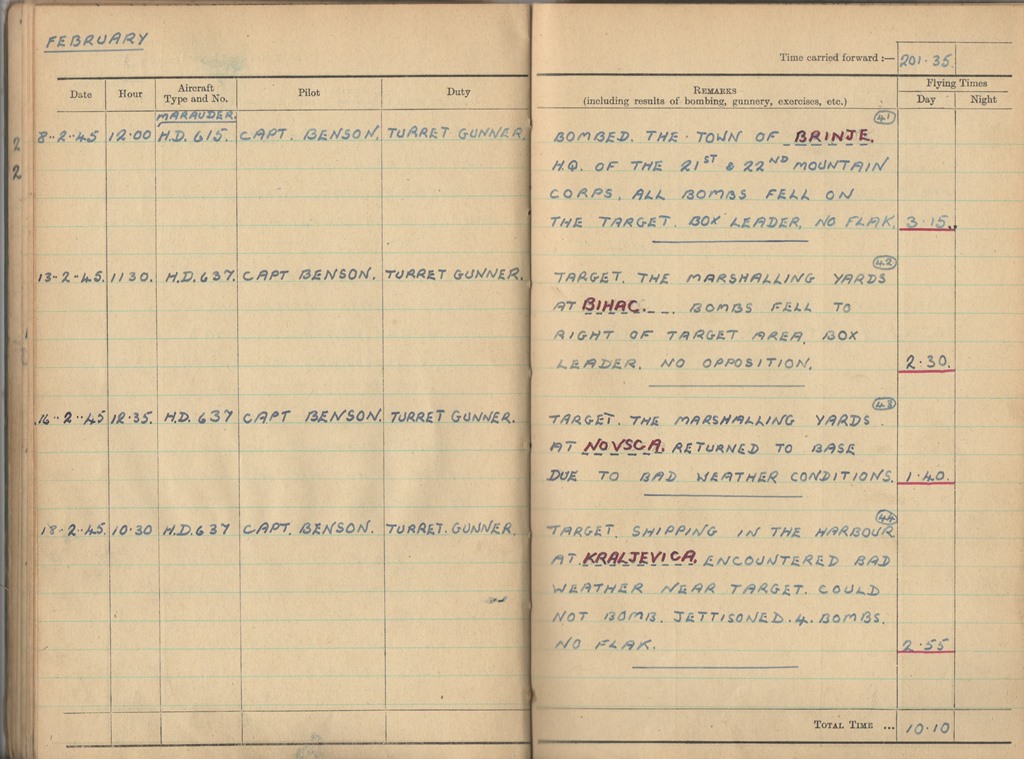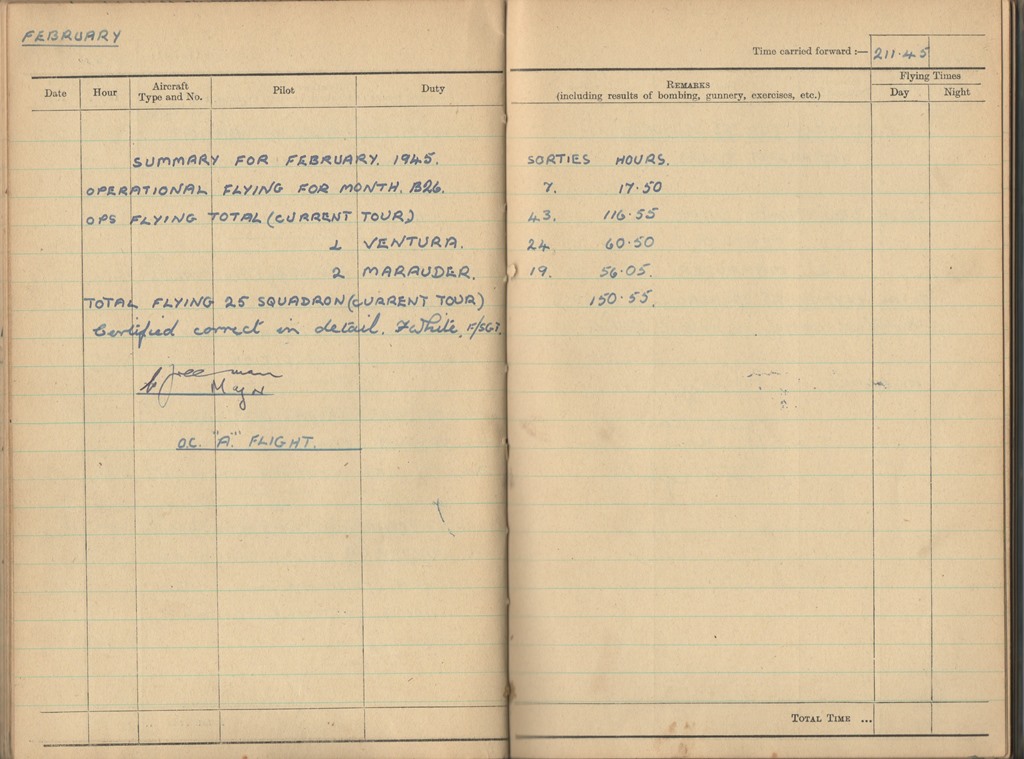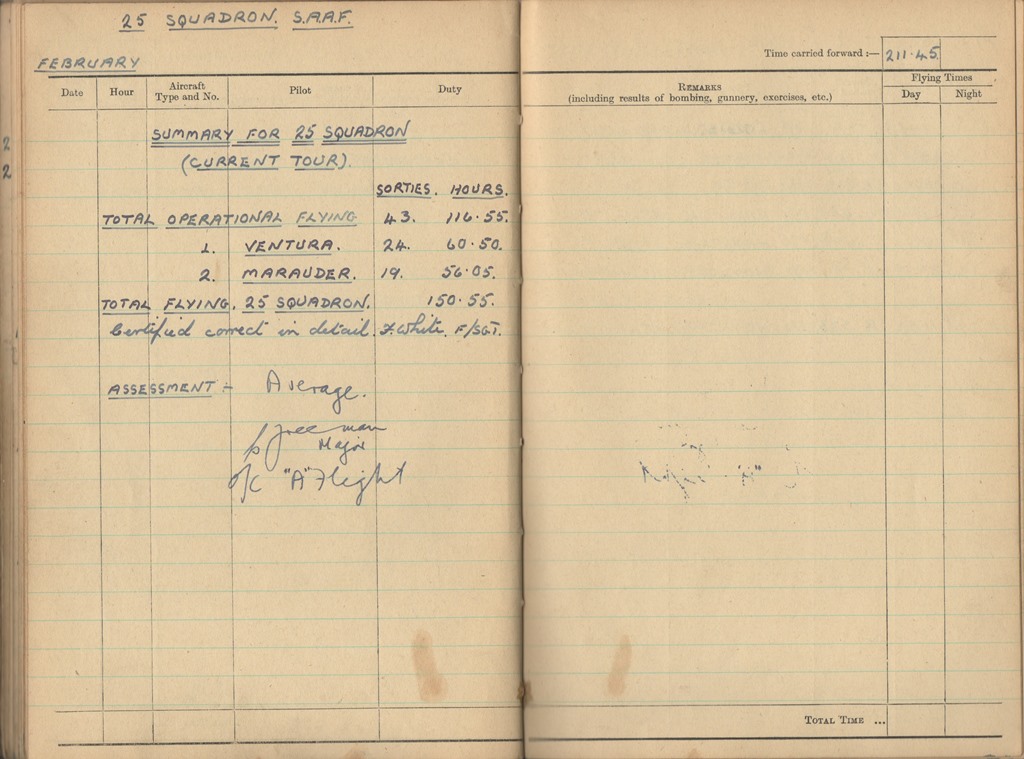Tribute page: WW2 RAF WOP/AG Frank White
Hi and welcome to this site!
Thanks to Neil White who kindly send me information and scans of his father's war log book/photograph album.
Tinus le Roux, August 2020
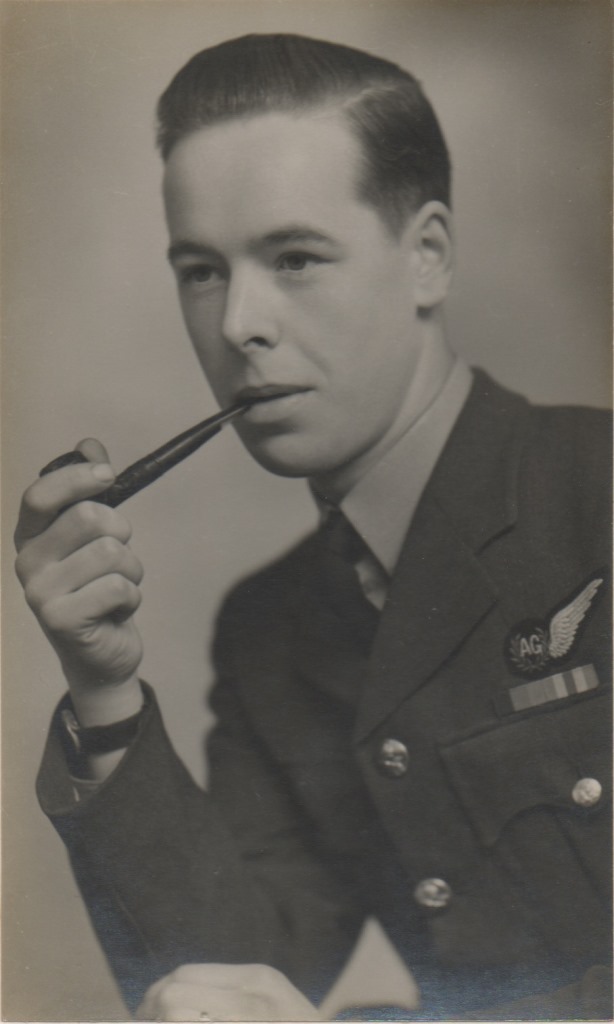
FRANK WHITE - Wireless Operator / Air Gunner 25 Squadron SAAF 1944-45
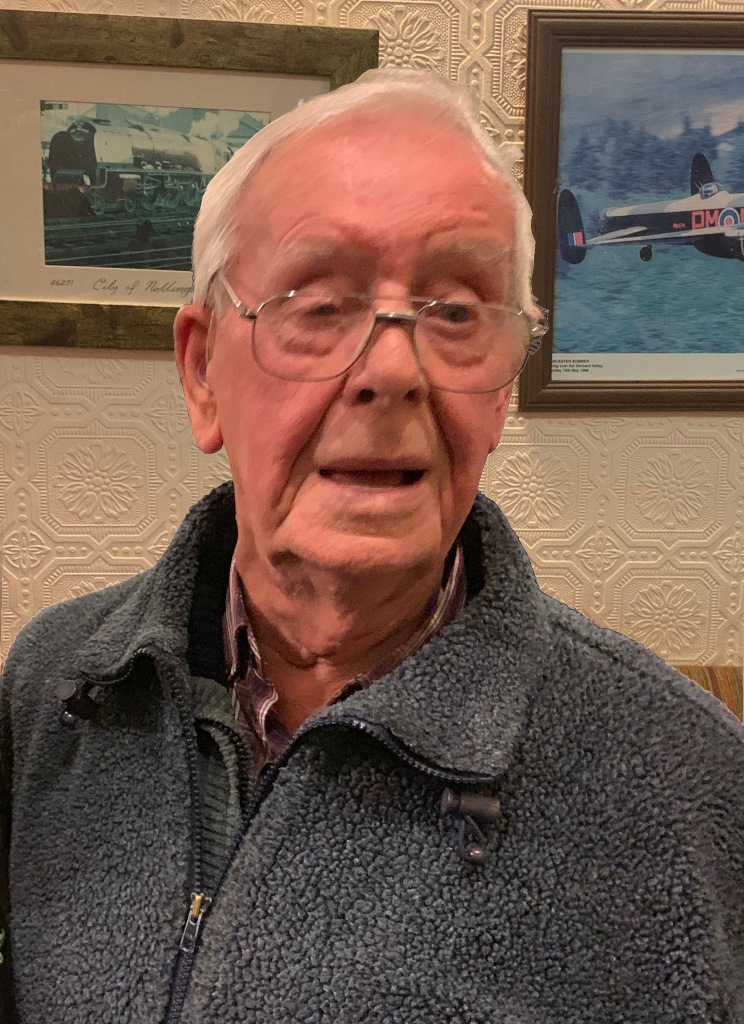
This photo was on his 96th birthday at the local pub, two weeks before he died.
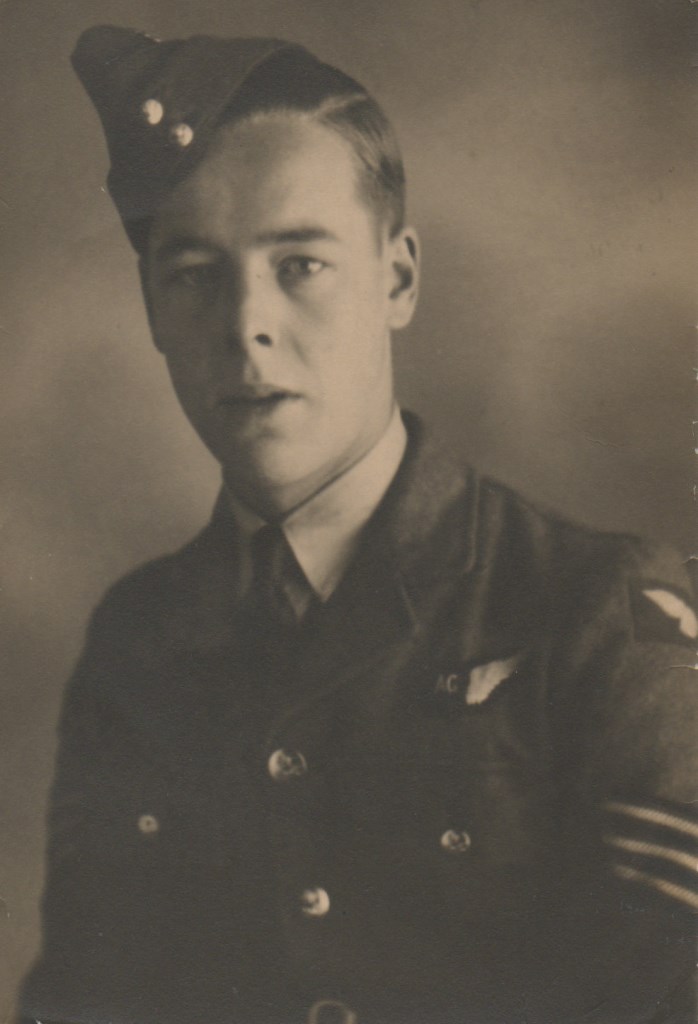
FRANK WHITE'S WAR YEARS (Extract from life story).
1941 – This was when my actual flying career started as I was a founder-member of the A.T.C. Ilkeston 348 Squadron based at the headquarters in Oakwell Drive Grammar School joining with friend Ted Martin. I Did morse training, basic radio study and plenty of square-bashing! I Learned about machine guns also with the aid of the Territorial Army. I flew in a De Havilland Tiger Moth from RAF Newton and later in a Miles Magister from RAF Burnaston during training. I went to Viceroy Close, Birmingham for 3 days to take 'Aircrew Selection' aptitude tests to see if I could fulfil my desire to join the RAF as an Air Gunner / Wireless Operator (I did not wish to be a pilot), but unfortunately at the time they were not recruiting. This was a great disappointment to me. (Really I suppose I wanted to follow in the footsteps of my brother Ron who was already in the RAF crewing Sunderland Flying Boats in Coastal Command. He spent most of the time in 270 Squadron, West Africa). I was advised to join as a ground wireless operator, and then ‘Re-muster’ later on when there were opportunities in this field. All this training did give me a good grounding for later when I was to actually join the Air Force.
At this time at Lewis's I Moved on to fully-fashioned stocking machines, producing for WAAF & ATS.
1942 – On 13th June 1942 at age 18 I was called up for active service and joined the RAF as a ground wireless operator (following the advice given on the aptitude tests). I was sent to Padgate, Warrington, Lancashire first to be kitted out and from there went straight to Blackpool No. 10 Radio School where I started my basic training in radio, Morse Code, ‘Square Bashing’ etc. From here I was posted to No. 4 Radio School, Madley (near Hereford) for more advanced radio training. During the time there I was able to re-muster as UT (Under training) air crew, this was entirely voluntary, and was indicated by a white 'flash' in the front of my Forage cap.
1943 – At Madley I did flying radio training starting on 27th July 1943 in a De Havilland Dominie equipped with 1082/1083 transmitter/receiver sets and a Percival Proctor which had Marconi 1154 / 1155 sets. My total flying hours whilst there were 20 on Dominies and 16 on Proctors. I passed the course and qualified as a Wireless Operator -Air on 12th October 1943 and then was sent with a few close mates to RAF Cranwell, Lincolnshire on a lengthy ‘conversion’ course intending to qualify as Wireless Operator/Mechanic. About half way through the course 3 or 4 of us got fed up with it as there was no flying involved and, perhaps unwisely, jacked it in and returned to Madley to do the air operating course, which I passed OK. Next I went on a ‘No. 27’ gunnery course at No. 3 Air Gunner’s School on the Isle of Anglesey. Halfway through the course it was relocated to Castle Kennedy, Wigtown, (near Stranraer) Scotland so we all had to move there by rail. I flew in Avro Ansons there from 6th November to 9th December 1943. I passed this course, qualifying as an Air Gunner on 11th December 1943 and obtained my ‘Three Stripes’ making me a Sergeant. At this time I was sent to No. 11 Radio School at Hooton Park (on the Wirral in Cheshire) to do a Radar course No. 125 comprising ASV – Air to Surface Vessels, BABS – Blind Approach Beacon System etc. flying in Avro Ansons and Blackburn Bothas from 23rd December 1943 to 26th January 1944.
1944 - I passed this course qualifying as an ASV operator on 26th January 1944 and after a short period of leave, I returned to Blackpool for ‘pre-embarkation’ i.e. to prepare for the flying we would have to do overseas. In May we were kitted out with tropical clothing and a parachute and then went to Liverpool by rail where we boarded the Pacific & Orient liner ‘Orion’ at Gladstone Dock. None of us knew where we were actually going! We were escorted in convoy by warships. After being at sea for around a week, we passed through the Straights of Gibraltar into the Med, then after about one more week we docked at Port Said, Egypt (at the end of the Suez Canal) where we disembarked. After only a few days there, many of us were sent by train to Jerusalem. There we stayed for about 5 weeks and trained on ‘Bendix / Westinghouse’ radio equipment etc. During the time there the invasion of Europe took place on June 6th. We numbered about a dozen at that time and discovered that we had been seconded to the South African Air Force! We then were transferred by train to their main base depot at Almarza, Egypt (about 6 miles from Cairo) to join them. This was my first meeting with the South Africans, who proved to be very friendly people. We spent some time there with them, still not knowing what we were actually there for, before being flown in a Dakota by the American Transport Command on 6th July 1944 from ‘Paine Field’, an American air base to Benghazi, landing en route at Benina Airport, Libya for food and re-fuelling. We then carried on, still not knowing where we were heading, finishing up at Capodichino Airport (just north of Naples) Italy. No-one knew then why we were there or what we were required to do! After awhile we were picked up by a South African officer, Major Frewen, the Adjudant of 25 Squadron SAAF, who took us to their base at Pomigliano d’Arco to join his Squadron there, and we were made very welcome. 25 Squadron were part of the UDF (Union Defence Force) which itself was part of the CMF (Central Mediterranean Force) operating over the Balkans. I did some air gunnery training there on B34 Venturas (but only on two flights, one on 21st July which was piloted by Lt. Tucker, and the other on 29th July piloted by the C.O. Lt. Col. Lawrie Shuttleworth). On 27th August I was W/Op. on a flight from Pomigliano to Pescara piloted by F/O Leadbetter. Whilst there walking around the airfield I spotted a German helmet on the ground and thought that I would take it as a trophy. However when I picked it up the head was still inside it so I dropped it fast! After about 2 or 3 weeks at Pomigliano, the whole squadron flew over to the Adriatic coast to our actual base at Campomarino, which was just south of Termoli. This place was often referred to as 'Biferno' because this was the name of the river it was on. There were no permanent buildings there so we were housed in tents near the beach. There was a makeshift airstrip formed out of interlocking steel mesh, known as ‘PSP’ (perforated steel plank) which was laid on hessian. Soon we were 'Crewed up' where it was decided which crew individuals were actually going to join. I believe that the pilots had a large say in who they wanted! We were then all issued with a .38 Smith & Wesson hand gun. The squadron was divided into 2 flights, A and B. A flight was commanded by Major George Freeman, and ‘B’ Flight by Major Thresher. I flew in ‘A’ Flight as part of the crew of 4 with three South Africans, pilot Capt. Basil Benson, Navigator/Bomb Aimer Jack Edkins, and Wireless Operator Lt. Axelrod (I never did know his first name!) From there we did operational flights in Venturas over Yugoslavia, Albania, Greece etc. We carried a Sten gun in the aircraft on these flights. My first operational flight on a Ventura was on 1st September 1944 over Yugoslavia, and many more such flights followed. On 13th October 1944 we got up very early and flew via Brindisi, Italy (to refuel and pick up the bomb load) then on to Volos, Greece in order to to bomb the harbour, quayside and shipping etc. It was a very successful mission, and I have photographs of the targets. We returned to the same location on the 16th October and had another successful mission. In early November we were supplied with brand new aircraft, which were B26 Marauder bombers (Models F and G) and we converted to these. Marauders needed a crew of 6, so we were joined by Albert Kirton, another RAF Sergeant (who was in fact one of my old mates!) and another South African, Lt. Fred Zunkel, who was Second Pilot to Capt. Benson. Both pilots had to take a conversion course in order to fly these aircraft.
My first operational flight in a Marauder was on 9th November 1944 on Aircraft No. HD577 although my usual plane was to be HD637. On this first mission we went to Konjic. Later the same day I flew with Capt. Benson again, but this time I was ‘Tail Gunner’. My usual job in later missions was ‘Mid-Upper’ gunner. The Marauder bomber had a total of eleven 0.5” Browning Machine Guns: there were two in each of the turrets, two at the ‘Waist’, two each side of the fuselage in ‘Pods’, and one in the nose. For this reason it was particularly feared by the Germans. On the 12th November 1944 I was on a mission where I was W/T (Wireless Telegraphy) operator. We were truly multi-skilled!
1945 – In January Albert Kirton and myself were both promoted to Flight Sergeant. I continued operations on Marauders until my last one on 18th February 1945 flying in HD 637 to Kraljevica, Croatia. My tour of duty was cut short at this point as I was informed that my Father had become very ill and had been taken to Nottingham General Hospital. Sadly he died there during an operation for stomach cancer. I was acutely aware that my Mother was now having to look after three young children alone and that I was actually the nearest to home of her three eldest sons all of whom were in active service. (My brother Ron was in West Africa at the time on 270 Squadron operating on Sunderlands, and my other brother Paul was a dispatch rider in India). As I had completed a good proportion of my tour of operations I applied for a ‘Compassionate’ posting back to the UK. After some help from the British Legion, this was granted. I was considered 'operationally tour expired'. Having nothing except the clothes I was wearing and my bag of bits and pieces, I hitched a ride on a squadron lorry on it's way to Naples. I stayed overnight at a personal transit camp (PTC) near Naples. The next morning I made my way to Capodichino airport, where on the 25th February 1945 I managed to get a lift on an American Dakota bound for England. After a few stops on the way (Marseilles, Dijon, Paris for refuelling) we landed back in England, actually arriving at Bovingdon, Hertfordshire. From there I ‘cadged’ a lift on a bus to London as I had no money at all! I saw the RTO (Railway Transport Officer) at St. Pancras station and he issued me with a ticket to Nottingham, from where I was kindly taken home in a car run by a voluntary transport service, arriving at around 3.00am! My overseas service was officially ended on 29th March 1945. I spent almost three months at home as I received no further official instructions. During this time, in the ‘Crown Inn', Awsworth I first met the lovely Edna who was there with her Mum and Dad, and I knew straight away that she was the one for me! From then on I spent as much time with her as possible. At that time she was living with her Mother, Father and elder Sister Gwendoline at ‘Gwenholme’ opposite what is now the Gardener’s Inn, Cossall. Whenever I was there with her the family kindly fed me as well as they could afford. One day whilst on a pic-nic with Edna down Babbington Lane (opposite) I proposed to her and to my delight she said yes! In the midst of my happiness at this time though, there was something bothering me! I was really concerned about the lack of contact from the Air Force during the length of time I had been at home so I wrote to the Air Ministry Records Office in Gloucester to inform them that I was still home. They passed the letter on to the Air Ministry at Adastra House, Kingsway, London who promptly sent me a telegram telling me to report to the Ministry, and they sent a rail warrant for this purpose. I went to London and saw a Squadron Leader who commented that I had had a good period of leave! I said yes I had, that was my intention! He said that I had done the right thing by contacting them, but that I had left it rather late. I asked what he would have done in the same circumstances, and he said probably the same! Anyway he left it at that because he said we were both at fault!. He virtually asked me where I wanted to go, and after a few unsuccessful tries for somewhere VERY close to home, he finally arranged a posting for me back to the Radio School at Cranwell. In June I went to St Athan, South Wales where I did a 5 week ‘Air Operating Instructor’s’ course on Marconi 1154/1155 sets flying De Havilland Dominies until 26th July 1945. After passing this course I returned to Cranwell and became an instructor at No.1 Radio School. The school had use of a fleet of around 10 Percival Proctors and 3 De Havilland Dominies. My first trip as ‘WOP’ was to RAF Mildenhall on 10th August 1945. I finally took over the running of the school when the officer in charge was de-mobilised. I greatly enjoyed this job, which lasted for around 6 months. During the time I was running the school, for some strange reason I was posted to Compton Bassett, Wiltshire for a basic ground wireless operator's course! I took great exception to this as it was so obviously unnecessary and would have ruined my wedding plans as it would have been at the same time as my wedding date!. However before I had to go there my pilot 'Curly' Hyland and myself had occasion to take Air Vice Marshall Cassidy (whose command included Cranwell) back to his base at Southrop in Gloucestershire and I raised the point with him. He appeared to politely listen but made no comment, however shortly after this time the posting was cancelled, obviously due to his instructions. I was very grateful for this! There was a communication breakdown somewhere as I was reported AWOL from Compton Bassett. They had obviously not been notified of the cancellation! In October 1945 Edna and I had a holiday at Butlin's, Filey and then were married on 24th November by the Rector of Wollaton, the Rev. Giles at Cossall St. Catherine's Church. We had our honeymoon which was based at Osborne House, Forest Gate, London. As the war was still on, it was all ‘blacked out’ there! During the Honeymoon we went to see Ivor Novello's 'Perchance to Dream' at the Hippodrome Theatre and I bought Edna a dress set (on the black market!!!)
At this time Edna was working at Rolls Royce, Ilkeston Junction as a switchboard operator with her friend Joan Crisp. Later she worked as ‘P.A.’ for Mr J G Ellis the Borough Surveyor / Engineer for the Broxtowe area at Rock House, Stockhill Lane, Nottingham.
1946 – In January I was promoted to Warrant Officer.
One Friday, just before a week's leave, a production unit visited my classroom to make a training film. Basically I was just filmed whilst teaching my students. At the end of the day, eager to go on my leave I asked if all was OK and the producer said that he was happy. He said that my voice would actually not be used and someone else's was to be dubbed over it! So I went home to start my leave. However over the weekend I was surprised to receive a telegram from Cranwell telling me that I must report to Marylebone Studios, Marylebone Road, London in connection with the film as they were going to use my own voice after all! I was a bit 'peeved' to say the least about this so I sent a telegram back asking if it was imperative that I go then as I had made holiday arrangements (although this was not exactly true!). They sent a second telegram saying that I must go. I went there taking Edna with me, and joined others including an RAF Squadron Leader who were all there for a similar reason. Afterwards the Director took us all out for a good meal! During the meal I mentioned to the Squadron Leader how making the film had messed up my holiday plans. He said that it would be OK for me to return a day later than the end of my leave, which I did. The next thing I know I am posted AWOL from Cranwell! I had to report to the Station Warrant Officer, but told him that I was getting rather 'fed up' with this whole business. I said that if he had any queries at all, then contact this Squadron Leader who had authorised the extension. I heard no more about it after this!
My last trip as ‘WOP/Instructor’ was on 23rd August 1946 and I myself was de-mobilised on 3rd September 1946 in Uxbridge, Middlesex. I had completed a total of 244.2 flying hours whilst at No. 1 Radio School, Cranwell. Altogether during my service I flew a total of 43 sorties, some successful, some not! Average duration of the flights was about 2 ¾ hours although they could last 4 hours. 24 sorties were on Lockheed Venturas and 19 on Martin Marauders, usually flying at around 10,000 feet. Other aircraft I have flown in during my service time are: De Havilland Dominie, Percival Proctor, Avro Anson, Blackburn Botha, Douglas Dakota, Airspeed Oxford and Handley Page Halifax. We were supplied with Oxygen but rarely used it. I enjoyed my service time really, and it was extremely exciting, although on reflection I can think of better things I could have been doing! However fortunately, in spite of our aircraft being hit on several occasions by 'anti-aircraft' fire, I never actually sustained any injury. We did come close to it though when after one raid our Ventura had to brake very heavily just as we touched down to avoid a lorry which had been driven onto the runway by a South African native immediately in front of us! The aircraft was damaged but we were all safe.
IWM Photograph of 25 squadron Marauders with Frank identified in the nearest group
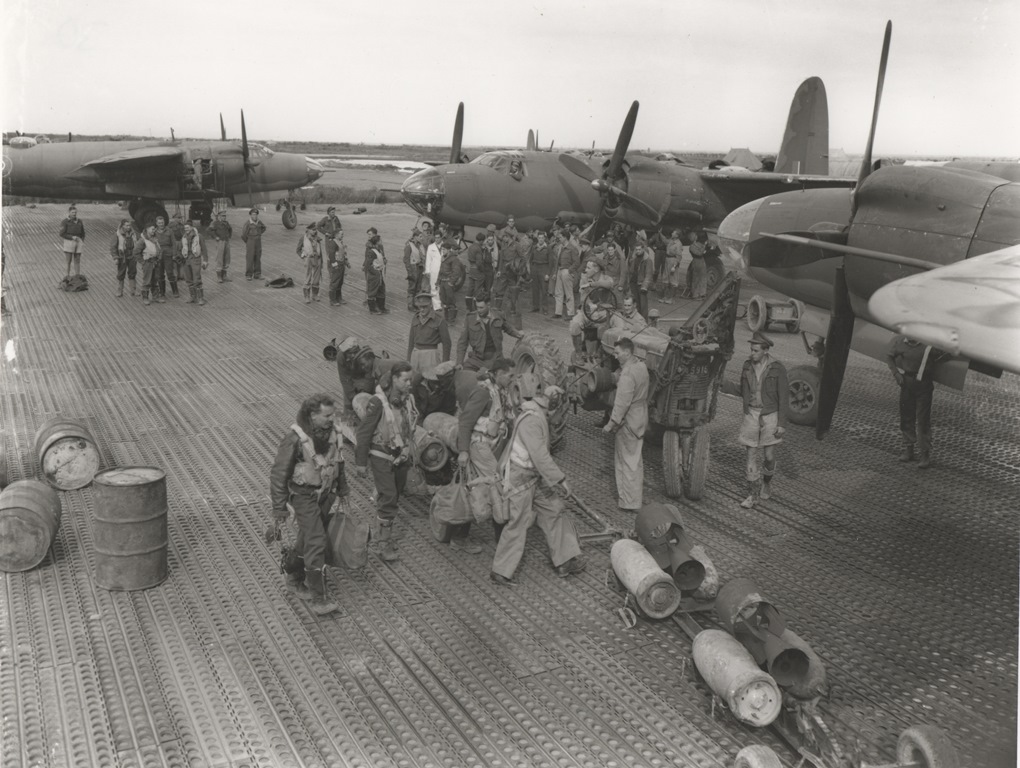
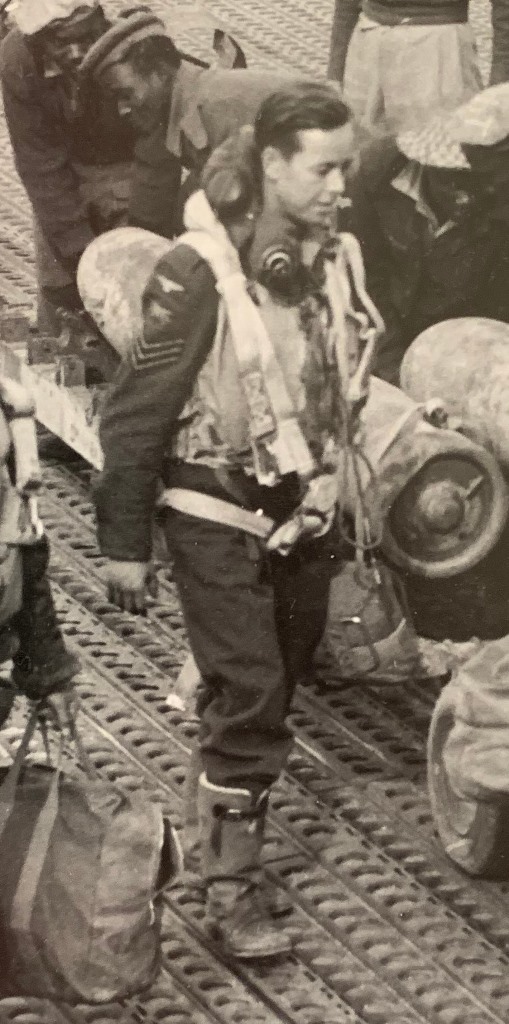
SAAF 25 SQUADRON LOG BOOK ENTRIES
